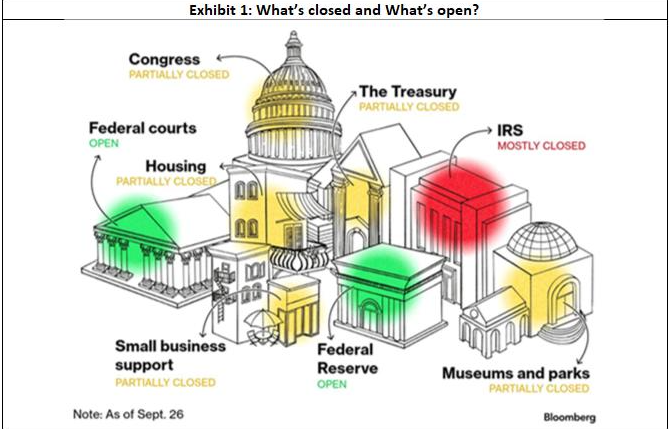Background
The 2025 U.S. government shutdown represents more than a fiscal impasse; it reflects a profound collapse of trust across America’s political system. Unlike previous shutdowns driven by specific policy disputes, this one is rooted in mutual distrust between the White House, Congress, and the public.
Democrats no longer trust the Trump administration to honour spending agreements, accusing it of withholding congressionally approved funds. The White House, meanwhile, dismisses Democratic overtures as political theatre. President Donald Trump’s second term has been marked by unilateral decision-making, an unprecedented volume of executive orders, and minimal bipartisan engagement. Office of Management and Budget Director Russell Vought’s freezing of $2.1 billion in Chicago funds typifies this defiance of congressional authority.
Within Congress, partisan hostility is matched by intraparty fractures. Democrats reeling from their 2024 election loss and are divided between centrist leaders and an emboldened progressive wing led by Bernie Sanders and Alexandria Ocasio-Cortez. Their base has lost faith in party leadership. Republicans, dominated by Trump loyalists, operate under a centralized “uniparty” approach that leaves little room for negotiation.
Public faith in institutions has deteriorated sharply. Gallup polling shows confidence in the Supreme Court has fallen to 27%, the justice system to 17%, and trust in the news media to historic lows. Nearly 80% of Americans now believe the nation is in political crisis.
Though the shutdown’s immediate economic impact is limited, some museums and military events are cancelled, the damage will deepen as federal workers miss paychecks by mid-October. The government’s $7 trillion budget footprint means prolonged disruption could ripple through the $30 trillion U.S. economy, threatening household finances and consumer confidence.
Past shutdowns ended through backroom negotiations between seasoned dealmakers like Mitch McConnell and Nancy Pelosi, both now sidelined. Today, no such bridgebuilders remain. With Trump releasing AI-generated videos mocking Democrats and Democrats struggling for unity, the crisis has become existential, not merely about budgets, but about whether the U.S. political system can still function on a foundation of trust. Until that is restored, the shutdown, and the dysfunction it symbolizes, could persist indefinitely.
What level of disruption is expected?
A US government shutdown occurs when Congress fails to pass appropriations legislation to fund federal agencies, leading to furloughs of non-essential employees and suspension of various governmental operations. While impactful to many sectors, its direct effect on financial markets is often muted and short-lived — though that depends on duration, economic conditions, and policy response.

Key Risks and Implications for Investors
- Volatility, risk off sentiment, safe havens In the near term, equity markets may see modest downward pressure as investors retreat from uncertainty. Volatility tends to rise, while safe-haven assets like US Treasuries and gold may attract inflows.
- Data blackout and policy uncertainty Many government agencies halt data collection or release, disrupting releases of economic indicators (e.g. jobs data, CPI). That complicates decision-making for investors and central banks, potentially increasing uncertainty around monetary policy.
- Modest economic drag The shutdown may shave off portions of growth, especially if prolonged, due to interrupted government spending, reduced consumer confidence, and delayed contract payments.
- Sector-level impacts Companies dependent on government contracts, defense, government services, and agencies may see cash flow delays or operational disruption. Conversely, some sectors may benefit: bond yields may fall (thus boosting fixed-income), and bargain-seeking investors might find long-term entry points in defensives or undervalued names.
- Historical context: bearable for markets In past shutdowns, markets have generally recovered quickly. For example, equities tend to
- dip modestly (or sometimes even rise) during the shutdown and often post gains in the 12 months after.
Expected Impact by Sectors
A shutdown introduces short-term noise and uncertainty rather than fundamentally altering long-term trends. Investors should stay diversified, avoid reactionary shifts based solely on political headlines, lean toward high-quality names, and monitor sectors most exposed to government spending risks. Staying alert to incoming data (both private and public) and policy signals will be key to navigating the noise.
| Sector | Expected Impact | Rationale / Key Dynamics |
|---|---|---|
| Defense & Aerospace | 🔻 Mild Negative | Contract payments and new tenders delayed; Pentagon operations continue but civilian projects may face short-term funding pauses. |
| Government Services / Contractors | 🔻 Moderate Negative | Contractors serving federal agencies may experience payment delays or temporary work stoppages. |
| Financials (Banks, Insurers) | ⚖️ Neutral to Mild Negative | Weaker consumer confidence and delayed data releases may slow lending decisions; however, rate cut expectations can support valuations. |
| Technology | ⚖️ Neutral | Resilient earnings and AI-driven growth continue to offset policy noise; limited direct government exposure. |
| Consumer Discretionary | 🔻 Mild Negative | Reduced confidence among furloughed federal employees and contractors; small dip in spending momentum. |
| Consumer Staples | 🔼 Mild Positive | Flight to defensive names as investors rebalance during volatility. |
| Energy & Commodities | ⚖️ Mixed | Oil demand expectations soft amid slowdown, but gold benefits as a safe haven. |
| Healthcare | 🔼 Neutral to Positive | Policy-sensitive, but less cyclical; steady demand. |
| Utilities & Infrastructure | 🔼 Positive | Defensive positioning attracts capital inflows amid political uncertainty. |
Possible Considerations Around Risk Hedging
- Focus on quality and defensiveness Investors should lean toward companies with strong balance sheets, low leverage, and recurring cash flows. Utilities, staples, and large-cap tech remain resilient.
- Consider fixed-income and gold exposure Falling Treasury yields amid uncertainty typically benefit investment-grade bonds and precious metals.
- Maintain diversification Shutdowns rarely cause lasting macro damage, so investors should avoid overreacting. Balanced portfolios with exposure to equities, credit, and real assets remain appropriate.
- Monitor data disruption Expect temporary uncertainty in macro readings (jobs, inflation), making private-sector data and Fed communication more influential for positioning.
- Watch for opportunity: Market pullbacks during shutdowns have historically been short-lived entry points for long-term investors, especially in undervalued cyclical sectors.

